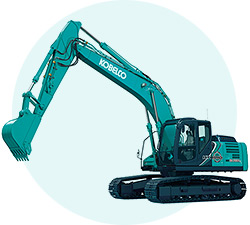
Currently, the reduction of greenhouse gases and Nox (nitrogen oxide) causing global warming, air pollution or health damage is major concern of the overall international community under the call of ecology and a sustainable society.
Excavators used at various construction sites for land leveling, digging and demolition urgently require energy-saving and environmental load reduction solutions. The current trend is the hybrid electric vehicle which has both the engine and motor as a power source.
In response to this situation, KOBELCO developed the SK200H-10, 20-ton class hybrid excavator which features the company's own hybrid technology.
Pursuing high durability and even lower fuel consumption
for the Model 10 Series
Koji Yamashita, the leader of this development project had this to say.
In 2012, we released the 20-ton class SK200H-9 with an overwhelming low fuel consumption performance that secured KOBELCO’s reputation for low fuel consumption.
For the SK200H-10, we wanted to succeed the high durability characteristic of the SK Series Model 10 while further lowering its fuel consumption. Also, the unit would feature a performance capability that would overcome any of the negative comments such as the work speed being inferior to those of conventional machines. The three keys to accomplish those goals were "upsizing the generator motor", "full motorization for revolving" and "adopting a lithium ion battery".
Building a driving system capable of high output
At the time when the development for the SK200H-10 started, adopting the use of a lithium ion battery had several hurdles to cross in terms of safety, resulting in the common view that "practical use was premature". However, KOBELCO not only responded to the “United Nations Recommendations on the Transport of Dangerous Goods” but also conducted tests that assumed construction sites under severe conditions that included vibration, impact, ambient temperature and surrounding dust. After fully verifying the safety, we decided on adopting a lithium ion battery.
At the same time, we were looking at upsizing the generator motor to increase productivity. Kazushige Koiwai, who was in charge of system development, remembers the following.
Seiji Saeki, who was in charge of production design, he proudly proclaimed the following.
Investigating the optimal solutions with a wide view for the whole system applications
For the SK200H-10, each and every component was developed by KOBELCO to heighten the compatibility with the product concept. This included the controller for the hybrid excavator which is typically produced by a specialized manufacturer for the conventional machines. So, KOBELCO sent its development engineer, Sho Fujiwara, to a control manufacturer.
Later, development moved to the next phase, the tuning of the operability and usability of the hybrid machine. At this stage, we conducted a mutual adjustment of various fields that pursued the best methods to bring out the best system. To put it simply, our theme was "partial optimization to overall optimization".
 The SK200H-10 boasted the highest level in low fuel consumption and its productivity was 18% more,
The SK200H-10 boasted the highest level in low fuel consumption and its productivity was 18% more,
compared to the S mode of the SK200H-9.
Linking a customer-oriented posture to performance
For overall optimization, we needed to construct a dedicated bench test environment in the factory. This was not just for evaluating the performance of a hybrid machine unit, but also for evaluating the performance of a combined system. Repeated examinations were conducted, adding conditions such as temperature and load changes to fully test the machine’s power, reliability and safety.
Furthermore, with the support of our customers throughout Japan, from Hokkaido to Kyushu, we carried out monitored operations with a prototype. Installing sensors at each point of the machine, we collected data and took the on-site suggestions for improvement from our customers and provided the feedback to our development group.
This machine was equipped with electric motor for turning. We were able to smoothly tune the unit by repeated tests and taking in the opinions of our monitors. In addition, the engine is assisted by a large generator motor that helps maintain the necessary power even if the engine's rotation speed is lowered. At the same time, we also succeeded in improving the work environment of the operator due to reducing the noise by the engine's rotation cutting.
In this manner, the unit passed a substantial number of quality confirmations that lead to the completion of the SK200H-10.
We want people to try out this machine, including those who gave hybrid machines a wide berth due to doubts concerning operability and power, as well as those who were unsatisfied with the performance of other hybrid machines. That's the message from our confident engineers.
SK200H-10 Innovations

1. Upsized generator motor
Realized the top-level motor output for a 20-ton class which secured an operational capability that was equal to conventional non-hybrid machines.
2. Electric motorization of turning
Installed an electric motor for turning and utilized the energy used for turning so far for operations such as digging, to improve the machine's productivity. We also focused on tuning to allow a turning operability that was equal to that of standard machines.
3. Adopted a lithium ion battery
Because it can continually retain stored electricity, the retained energy can be used to hold down the engine output, depending on the load range.
* The contents described above is based on the information at the time of issuing (October, 2016).








Yamashita
First of all, KOBELCO has a track record as the pioneer of hybrid excavators. From 1999, the company joined hands with the Technology Development Division of Kobe Steel, Ltd. to begin the research and development of hybrid technology. In the Spring of 2006, KOBELCO introduced the SK70H, its first hybrid excavator at Intermat, the international exhibition for construction machinery held in Paris. In September 2009, the company launched the sales of SK80H. This unit went beyond our expectations of a 25% decrease in fuel consumption, actually achieving a reduction of 40%.